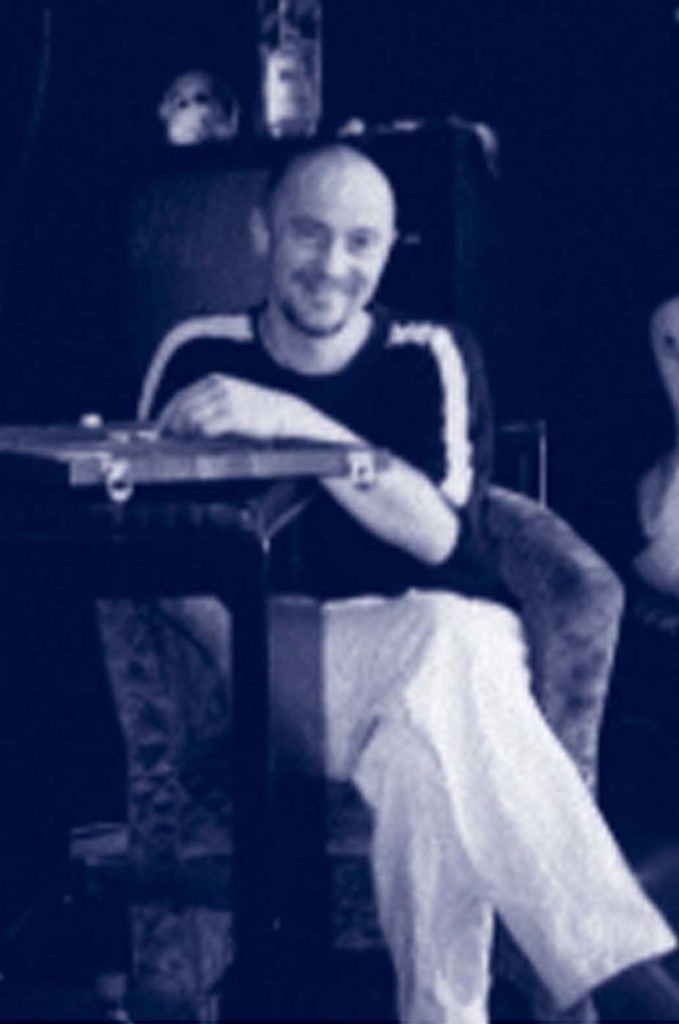
Patrick King is a spectacular Thelemic figure who like so many pioneers left a dearth of documentation. The principal source for his own recollections is Liber Qadosh, his diaries.
Just as a discussion of John Dee must start with some understanding of Meric Casaubon, discussion of the personal life, particularly the later life, rather than work, of Patrick King must include the most significant personal biographical resource, the iconoclastic Swiss author Peter-Robert Koenig, author of “Das OTO Phänomen” (1994) and “Gestatten, Under-Cover Agent Peter-R. Konig,” (1998). From Irenaeus to Symonds, the problem of hostile accounts is so common in the world of esoteric history that it must be taken in stride, as virtually no biography can be put together without resort to hostile sources.
Like Symonds and other historical authors, Koenig is at once highly critical of, and fascinated with, his occult subject matter. His technical details appear to be accurate, though his overall attitude towards Thelema is hostile. In fairness his principal issues seem to be with the fascistic and totalitarian undercurrent that we also deplore.
Even so, Koenig is not always evenhanded or fair, and must be a suspect source. For our purposes, however, he seems to have sympathized with King, and published excerpts from his private correspondence with David King, Patrick’s brother, which is one of a limited number of sources for an outside look at King.
Patrick King, born in 1955, was a Salt Lake City resident, who entered Thelema after reading Llee Heflin’s “The Island Dialogues” through the world of Haight-Ashbury in the mid 1970s. His father was Harold Scott a professor of biblical history and Christian religion at Harvard Divinity school. whose papers are collected at the Harvard Divinity School Library.
He was active in the esoteric scene early on in Salt Lake City. David King states “‘The Church of the 4 Sided Triangle’ was formed by Patrick King, Lonie Davis, Joe Frank, Corin Covington, Cell Heidle and Jeff Price. It was intended to acquire the protection of the law as a church for the group. I believe that it was registered with the authorities in SLC as a formal church organization.” He comments that “Patrick was a leader of the group in SLC. He was lovers with several of the group, (I don’t know exactly which ones). Homosexuality was never an issue within the group.”
In San Francisco, King first fell in with a group of people associated with Heflin, and Level Press. In Liber Qadosh he wrote “There was an incredible amount of energy around this group at this time. Most of these people were already well involved with magick in its many and varied forms
but most especially the XIth degree conception underlined everything in their community. Only later was I to understand the genesis of these people from the old Kaaba Clerk House and their relations to Grady L. McMurtry.”
King, who by this time had significant experience in the occult milieu of the mid and late 70s, sought Grady out through Robert Anton Wilson and joined his then nascent Thursday evening group, which “along with maybe 7 other people organized the re-birth of the modern O.T.O. I was immediately made the Official Representative of the Order in the City of San Francisco and personal Herald of the Caliph in the Outer,” an account borne out by other living testimonials.
King who was what would now be regarded as pansexual was aware that McMurtry had a strong dislike for Llee Heflin and Level Press. Furthermore according to King McMurtry “didn’t much like “weak sisters” or in other words – homosexuals. In fact people were generally afraid to bring the matter up with him.”
King was determined to “to test both myself and the fledgling new group.”
From Liber Qadosh
“Encouraged by ATHANATOR, I undertook the adventure of re-creating Ex Nihil Lux the lost Councils of the XIth degree once again within the recognized body of the Order. First I secured the aid of most of the influential members of the Order to support (at least passively) my enterprise and then presented the Caliph with documents announcing the advent of The Rite of Shiraz XIth degree Ordo Templi Orientis. This was in 1978 the night before I was to take the 1st degree of the Order. I had already determined to leave the organization if Grady did not sign the documents and could not produce legitimate objections to them. My previously mentioned co-conspiritors anxiously awaited my corpse to be brought out the front door of Grady’s house. No one expected me to escape expulsion from the Order, let alone my success. The Caliph signed the documents after only a few questions thus vindicating my certainty in the Order and incidentally raising me to the rank of a Supreme Grand Master of the XIth degree. I must note that the Caliph did not hold (nor did he want to) this degree. Nor did he bestow it upon me. I re-created the eleventh degree O.T.O. based upon my own research and experiment – the Grand Lodge then “recognized” the new Rite of Shiraz and myself as the legitimate representatives of that Current. I immediately formed the Council of the Degree around 4 members including myself and this was known as the Z’tuch Qadosh.”
When interviewer Koenig asked “why Grady would allow Patrick to operate a homosexual branch of the O.T.O.,” (not strictly speaking true), David King stated that Patrick was not yet out of the closet when he launched the Rites of Shiraz. A principal parnter of King in the undertaking was
Waldo Pasquala Willson (i.e. Pasq) Fra. Dionysus.
Patrick King was the descendent of a noted scholar and possessed of a first class mind. Said David King “Patrick referred to the O.T.O. as an intellectual book club. Academic one-upmanship was the favourite game. This was true in SLC of the Church of the 4 Sided Triangle. I am quite sure that this is what attracted Patrick and me. “
The Rites of Shiraz are an important step in the re-creation of Thelema. In the repressive atmosphere of the late 1940s, many of the custodians of Crowley’s memory were intent on repressing the queerness that had defined his life. There were various reasons. Yorke seems to have been concerned it would “detract” from his message and materials, rather than understanding that it was core to his message of gender and sexual freedom, that the essential freedom of Thelema was incomplete without the understanding that gender is personal and unique.
There are allegations that Crowley left a longer XI° paper which has been lost or repressed, but in many ways that is not important. The language and concepts of Crowley’s time were inadequate to produce a fully modern XI° ritual. King’s ideas may also be imperfect but they represent a step on the route to a modern understanding of Thelema’s mysteries, particularly the understanding that what are, in early 20th century parlance “sexual mysteries,” can be understood in the modern era as both gender and sexual mysteries.
In an editor’s note in his interview with David King, Peter Koenig claims that the Rites of Shiraz “are motly authored by Laura Deerfield but based on Patrick King’s ideas.” The details of this bear further investigation, but do not undermine King’s important role in reviving the queer core of Thelema, though they do speak well of Deerfield and indicate a partnership of the sort we see so often in esoteric work. A thorough history of the Rites must also involve exploration of the role of others in establishing them.
The circumstances of King’s explusion from O.T.O. have generally been presented as a conflict with the new O.H.O., William Breeze, Hymenaeus Beta, who took control of the California based group run by McMurtry in 1986. The written and anecdotal accounts are not particularly flattering to Breeze, however in fairness they were penned by critics. In any case the issues seem to have revolved more around a power struggle within the organization than the specific merits of King’s ideology and work.
David King completes the narrative of Patrick’s final days. “After his expulsion from the O.T.O., Patrick was depressed and asked his friend and lover Laura Deerfield to go with him on a whim. They had little money and arrived in Europe broke…”
In matter of fact there seems to have been some years between Patrick King’s explusion, and his trip to Czechia, which can be dated about 1994-1995 by the subsequent account.
David King states that Patrick King and Deerfield had travelled to Prague because it was a “cool place to go,” and intended to stay there a few months before travelling to China, but remained for about three years. “She was his lover and went with Patrick to Europe and was staying with Patrick when he passed away. She described living under a bridge with Patrick in Prague, CZ, during the winter months and freezing as they couldn’t afford an apartment. I don’t know whether she was a member of the O.T.O. She clearly knew something about Sex Magick. She told me that she and Patrick practiced Sex Magick together.”
According to Koenig (it is unclear but appears he is paraphrasing Deerfield) Patrick King died on September 29, 1997 in Prague, Czechia. “Patrick King died of complications due to a beating of the Czech police as the result of a dispute with his landlord. His head wound never stopped bleeding and there was reason to suspect that he was bleeding internally. In fact he died when an electric radiator caught fire and filled the room with smoke. It may be considered a complication of the beating, since the only reason King and his friend staying at the little artist-collective-to-be (the building was still being fixed up) was because they had been locked out of their apartment.”
The thread of King’s work survives though it is relegated to limited editions and obscure corners of the internet.
King is interesting for several reasons. He represents a sort of re-intersection of the gestalt tradition of Thelema propagated from Cameron and other Beat era notables through the media of the Sexual Revolution and the direct tradition maintained by the surviving Agape Lodge members. With Cameron and Parsons his work represents one of the most remarkable and notable contributions to Post-Crowley Thelema, and probably one of the least understood.
King’s work is also at least a steppingstone if not a full portal, into the full gender and sexual mysteries of the new Aeon. It represents the continued maturation of Thelema as language and culture have evolved to catch up with the outline roughed out at the dawn of the 20th century.
